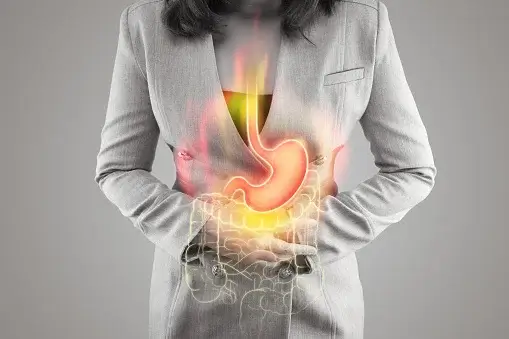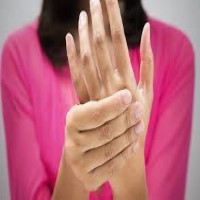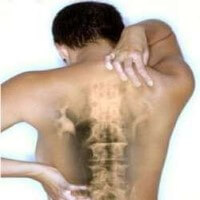GERD: Ayurvedic Treatment, Symptoms, Causes

Burning sensation, discomfort, and sleepless nights – GERD takes a toll. But there’s hope! Discover Ayurveda’s ancient wisdom for natural GERD relief. Say goodbye to the pain and hello to healing Ayurvedic treatment for GERD.
Our digestive system starts with the mouth or buccal cavity and ends at the rectum and anus. This system is well interconnected with each organ or system that plays its role in the process of breaking, absorption, assimilation, and digestion of the foods we consume.
GERD is a clinical condition where the acid formed in the stomach, whose function is to digest the bolus received from the esophagus (food pipe) is leaked backward from the stomach to the esophagus.
GERD or Gastro-Esophageal Reflux Disease is a chronic condition of the digestive tract in which the digestive acids frequently flow back into the esophagus. It is caused by an abnormality with the relaxation or closing of the gastro esophageal valve. In, GERD, the effect lies on the lower esophageal sphincter (LES); the ring of muscle between the esophagus and stomach. If GERD cannot be relieved through diet and lifestyle changes, the patients may require medication or surgery to get relief.
Signs & Symptoms
The most common symptoms experienced by the patients are-
- Heartburn – It starts from the epigastric region that is behind the breastbone and reaches up to the neck and throat.
- Acid Regurgitation – The hot, burning acid-like fluid which is bitter, and sour in taste is felt in the neck and mouth.
- Upper abdominal/Chest pain or even neck and side neck pain condition is seen in some patients.
- Pain during swallowing
- A sensation of a lump in the throat
- Sour taste
- Dry cough
- Sore throat
- Regurgitation of food or a sour liquid (acid reflux)
- Bad breath and wearing away of teeth
Causes and Risk Factors
1. Obesity
Obese people are more at risk of GERD; the excessive Kapha in the body vitiates Pitta and makes the condition more worrisome for overweight people.
2. Hiatus hernia
Some experts believe that the condition of a hiatus hernia can weaken the lower esophageal sphincter. In the hiatus’s hernia, stomach contents may reflux more easily into the esophagus and thereby increasing the risk of GERD.
3. Diet
Dietary and lifestyle choices also contribute to GERD. The foods and beverages, including excessive sweets, chocolates, peppermint, fried or fatty foods, cold drinks and coffee, may trigger reflux and lead to GERD.
4. Meal quantity
A large meal remains in the stomach for several hours, increasing the possibility that the stomach acids will seep into the esophagus and thereby increases the chances of GERD.
5. Smoking/Alcohol
Smoking increases the Pitta dosha in the body and leads to the condition of GERD. In Ayurveda, alcohol is also described as an ‘Amal’ that aggravates the condition of GERD and heartburn.
6. Stress
Stress has a direct role in aggravating the condition of GERD; it also hampers the secretion of digestive juices and the process of digestion.
7. Delayed stomach emptying
Delayed evacuation habits put more pressure on the stomach, and diaphragm and contribute to developing GERD.
Ayurvedic Diagnosis of GERD
According to Ayurveda, ‘GERD’ can be co-related to the aggravated state of ‘Amlapitta.’ ‘Amlapitta’ is made of two words Amla and Pitta where ‘Amla’ is associated with taste and Pitta is indicative of dosha. According to Acharya Chakrapani when the sourness of pitta increases along with its liquid state, it is the malfunctioning of ‘Annavah Srotas’ which is responsible for digestion and assimilation of the ingested food. Pitta is the dosha that is necessary for digestion but when this Pitta is secreted more than the required quantity, Agni gains ‘Amlata’; which means it becomes more acidic in nature.
This excess ‘Drava Svarup‘ (liquid form), leads to the following symptoms in the body.
- Hrit Daha (Heart burn)
- Tikta udgar (bitter taste in mouth)
- Avipaka (Indigestion)
- Klam (exhaustion without exercise or any physical activity)
- Utklesh (Excessive salivation/ nausea)
- Amla udgar (Sour taste in mouth)
- Kantha daha (burning sensation in the throat)
- Aruchi (Tastelessness)
According to Ayurveda, the condition of GERD gives rise to many digestive disorders which can be treated with a proper understanding of Aahar, Vihar, Dosha and Dhatu with the degree of their involvement. The damage caused internally in the gastric lining decides the duration of the treatment.
GERD in Ayurveda can be associated with Urdhawaga Amla pitta means the direction of symptoms are upwards. The symptoms of Amla Pitta in urdhava direction are associated with Khapha the symptoms are:
- Vomit – Green, yellow, blue, black, light or dark red in color.
- Ativa-ch amla – Extremely sour.
- Mamsodakabham – Looks like the water of washed meat.
- Ati Pichchilam – Very Sticky
- Accha Shleshmanugatam – Mixed with clear mucus.
- Vividh rasena – Salty, pungent or bitter in taste.
- Ashudha udgar – Belching with the taste of indigested food.
- Kantha, Hrut, kukshi Daham – Burning sensation in throat, heart and stomach.
- Shiraso Rujam – Headache.
- Kara charnam Daham – Increased burning sensation or heat in hands and legs.
- Aruchim – Anorexia
- Jwara prachiti – Feeling of having fever.
Self Care Tips
- Eat smaller meals and try to distribute the daily meal intake over three, four, or five smaller meals. This needs to be done under the guidance of a skilled physician who understands the science of food and nutrition.
- Stress increases the production of stomach acid. Try to make your meals a pleasant, relaxing experience. Sit down, eat slowly, chew completely, and enjoy the meal.
- Remain upright after eating. Maintain postures that reduce the risk for reflux for at least three hours after eating. Don’t lie down, bend over, or strain to lift heavy objects.
- Have an evening meal at least three hours before going to bed. Avoid bedtime snacks.
- Carrying an excess of pounds increases pressure on the stomach. This can push acid into the esophagus. So, shed the extra weight, if needed.
- Avoid tight belts, waistbands, and other clothing that puts pressure on the stomach.
- Abstain from food or drink that stimulates the stomach to make more acid, decreases the pressure in the lower esophageal sphincter, or makes the stomach empty more slowly. Known offenders include high-fat foods, spicy dishes, tomatoes, citrus fruits, garlic, onions, milk, carbonated drinks, coffee, tea, chocolate, and mints. The list is long, but you’re likely to see a substantial improvement if you cut out foods that cause symptoms.
- Stop smoking as nicotine stimulates the production of stomach acid and impairs LES function.
- Try to chew gum after having the meal as it can increase saliva production, soothing the esophagus and washing acid back down to the stomach.
- Ask your doctor or pharmacist if you are taking any medications that might cause more problems. These include aspirin, ibuprofen, naproxen, and other NSAIDs; progestin-containing hormones; and certain antidepressants.
- Give your stomach some time to be empty before exercising, and try to wait for at least two hours after a meal before engaging in some vigorous physical activity.
Yoga and Pranayam for GERD
Improper eating habits, inappropriate lifestyle and stress are a few causes of GERD, Yoga, and pranayama should be part of daily routine as it cleanses the mind and body, also helps in mobilizing toxins, strengthens body muscles and majorly reduces stress. They are part of lifestyle modifications.
Yoga like Kapalbhati, Agnisar kriya, Vajra aasan, Paschimottanasan, Supta badhakonasan, Manjartasana, and Ardha Matsendrasana are a few yogic aasans that help in improving the tone of muscles in the abdomen, gives strength to the diaphragm, thus it decreasing the acid reflux from stomach to esophagus.
Pranayama are breathing exercises involve long deep inspiration and expiration which clears the respiratory passages increasing the flow of oxygen into the blood which helps in removing toxins (Ama) and also reduces stress which is one of the major causative factors in the prognosis of GERD.
The precautions to be followed doing any physical exercises that should be performed according to strength and ability, seasons also need to be considered while performing any exercise.
Ayurvedic diet for GERD
One should follow the meal having kokam juice, sweet lime juice, Pomegranate juice, and Medicated water With ushir (wala) or coriander seeds, or laja (puffed rice). Shadangodak (water medicated with musta, parpatak, ushir, chandan, udichya & shunti), Moramla (jam of amla), gulkand (jam of rose petals) can be taken singly or along with milk give good relief, dadimpak (sweet syrup of pomegranate juice).
Vegetables like white pumpkin, bitter gourd, Okra, all leafy vegetables can be eaten except methi which should be definitely avoided. Fruits like black grapes, sweet lime, Pomegranate, fig, dry fig, and black resins. You should also consult an Ayurveda doctor to get a comprehensive plan for your personalized care.
Lifestyle Modification
GERD aka Amlapitta; though believed to be acidity is a disorder of annavahasrotas and causes mansawaha dusti i.e. when the metabolic activity is hampered, it causes a loss of strength in the muscles and tissue which in return can’t hold the lower orifice of the esophagus causing the back reflux of acids.
Due to changes in lifestyle, eating and sleep pattern the doshas get vitiated forming Ama( toxins) which further graves the condition if not considered at the right time. Ayurveda believes in prevention is better than cure, so it becomes necessary that as the symptoms arise proper medication should be taken with proper diet changes.
Ayurvedic Treatment for GERD
1) Improving appetite
2) Help nourishment of the body
3) Regulating the acid metabolism in the body
4) Improve the ability of digestion & absorption
5) Treat inflammation and cause healing of the digestive tracts
6) Protecting the intestinal layers from the ill effects of acid
Amal-pitta is a disease where excessive vitiated doshas are accumulated in the body suppressing these doshas only with palliative medicines will never resolve the condition sooner or later the symptoms will reoccur. This is the reason patients with severe acidity or GERD keep on popping antacids and antibiotics but the condition remains the same or worsens.
Shodhan (cleansing of the aggravated and excessive doshas are necessary)
1. Vaman – medicated emesis (vomiting)
2. Virachan – medicated purgation (loose motion) will reduce the excessive doshas accumulated giving 50% relief in signs and symptoms.
After Shodhan chikitsa, doing Shaman chikitsa is necessary which will rectify the vitiated doshas and the physiological changes in the body.
- Panchakarma Anuvasan Basti – medicated oil basti for internal repair.
- Asthapan or Niruh basti – for detox and internal cleansing.
- Aahar, vihar parivarjan – changes in eating habits and lifestyle are equally important because they are one the major root cause for the development of the disease.
- Wheat and barley soups with pepper
- Laja sattu mixed with honey or sugar
- Pomegranate
- Garcinia fruit
- Barley
- Wheat
- Green grams
- Old red rice
- Warm water
- Sugar
- Honey
- Brinjal
- Bottle gourd
- Pointed gourd
- Old pumpkin
- Bitter Gourd
- Coconut
- Jowar
The Ayurvedic treatment of GERD focuses on the removal of excessive Pitta in the body while normalizing the pH of gut, the treatment modalities include detoxification and use of medications that bring wonderful results in managing, curing the GERD. Get ready to embrace a new path to wellness with Aas Ayurveda!







